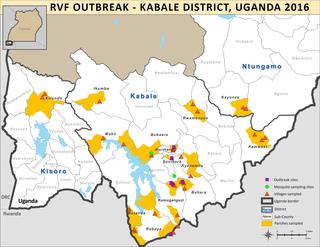PLOS Neglected Tropical Diseases ( IF 3.8 ) Pub Date : 2018-03-05 , DOI: 10.1371/journal.pntd.0006175 Annabelle de St. Maurice , Luke Nyakarahuka , Lawrence Purpura , Elizabeth Ervin , Alex Tumusiime , Stephen Balinandi , Jackson Kyondo , Sophia Mulei , Patrick Tusiime , Craig Manning , Pierre E. Rollin , Barbara Knust , Trevor Shoemaker

|
Background
Rift Valley Fever virus (RVF) is a zoonotic virus in the Phenuiviridae family. RVF outbreaks can cause significant morbidity and mortality in humans and animals. Following the diagnosis of two RVF cases in March 2016 in southern Kabale district, Uganda, we conducted a knowledge, attitudes and practice (KAP) survey to identify knowledge gaps and at-risk behaviors related to RVF.
Methodology/Principal findings
A multidisciplinary team interviewed 657 community members, including abattoir workers, in and around Kabale District, Uganda. Most participants (90%) had knowledge of RVF and most (77%) cited radio as their primary information source. Greater proportions of farmers (68%), herdsmen (79%) and butchers (88%) thought they were at risk of contracting RVF compared to persons in other occupations (60%, p<0.01). Participants most frequently identified bleeding as a symptom of RVF. Less than half of all participants reported fever, vomiting, and diarrhea as common RVF symptoms in either humans or animals. The level of knowledge about human RVF symptoms did not vary by occupation; however more farmers and butchers (36% and 51%, respectively) had knowledge of RVF symptoms in animals compared to those in other occupations (30%, p<0.01). The use of personal protective equipment (PPE) when handling animals varied by occupation, with 77% of butchers using some PPE and 12% of farmers using PPE. Although most butchers said that they used PPE, most used gumboots (73%) and aprons (60%) and less than 20% of butchers used gloves or eye protection when slaughtering.
Conclusions
Overall, knowledge, attitudes and practice regarding RVF in Kabale District Uganda could be improved through educational efforts targeting specific populations.
中文翻译:

裂谷热:乌干达卡巴莱区屠宰场工人和社区成员的知识,态度和行为调查
背景
裂谷热病毒(RVF)是Phenuiviridae家族中的一种人畜共患病毒。RVF爆发可能导致人类和动物的大量发病和死亡。在2016年3月在乌干达南部Kabale区诊断出两例RVF病例后,我们进行了一项知识,态度和实践(KAP)调查,以发现与RVF相关的知识差距和高风险行为。
方法/主要发现
一个多学科小组采访了乌干达Kabale区及其周围地区的657位社区成员,包括屠宰场工人。大多数参与者(90%)具有RVF知识,大多数参与者(77%)将无线电作为其主要信息来源。与其他职业相比,有更大比例的农民(68%),牧民(79%)和屠夫(88%)认为他们有感染RVF的风险(60%,p <0.01)。参与者最常将出血视为RVF的症状。在人类或动物中,不到一半的参与者报告发烧,呕吐和腹泻为常见的RVF症状。关于人类RVF症状的知识水平并没有因职业而异。然而,与其他职业相比,更多的农民和屠夫(分别为36%和51%)对动物有RVF症状的知识(30%,p <0.01)。处理动物时,个人防护设备的使用因职业而异,其中77%的屠夫使用一些PPE,而12%的农民使用PPE。尽管大多数屠夫说他们使用PPE,但大多数屠宰时使用靴子(73%)和围裙(60%),不到20%的屠夫使用手套或护目镜。
结论
总体而言,可通过针对特定人群的教育努力,提高乌干达卡巴莱区有关RVF的知识,态度和做法。



























 京公网安备 11010802027423号
京公网安备 11010802027423号